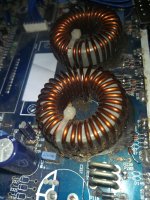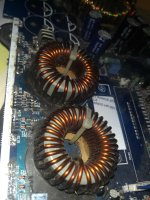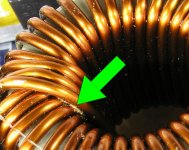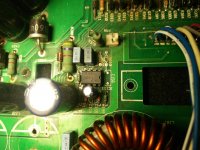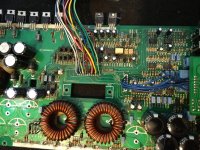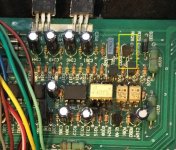Look for a powdery substance where the terminal winding meets the rest of the windings. See attached for an example.
The most common reason for the caps to fail is a drive problem causing one rail to increase. If that's not the problem, it could be shorted inductors. It's also possible that the terminal of the capacitor shorted to the board.
The most common reason for the caps to fail is a drive problem causing one rail to increase. If that's not the problem, it could be shorted inductors. It's also possible that the terminal of the capacitor shorted to the board.
Attachments
Could the rail filter inductor cause the rail cap to fail?
Can an unbalanced constitution of the rail caps cause another one to fail? (5 2200uf80v and 1 2200uf100v)
Can the rail caps be substituted with any other rating since that particular size is difficult for me to get??
I am unable to find 2200uf80v capacitors locally that are the same physical size as the originals. I purchased one 2200uf100v that is slightly larger and was able to fit it in the group. I powered up and rail voltage was between +/-65v and +/-71v. I noticed two things: If I push down on the driver board, the rail voltage would change, but mostly when pressing on the end with the IC that is closer to the RCA input and speaker output end of the amp. Also, there were some times when I noticed my mains tester lights were glowing dimly and the rail voltage had dropped to +/-60v. By manipulating the rail filter inductor I was able to get the light to come off and the rail voltage went back up to +/-71v. Then suddenly there was a loud pop, and another rail cap started to leak electrolyte. The amp still powers on and has +/-71v rails but I need to replace the rail caps.
Can an unbalanced constitution of the rail caps cause another one to fail? (5 2200uf80v and 1 2200uf100v)
Can the rail caps be substituted with any other rating since that particular size is difficult for me to get??
I am unable to find 2200uf80v capacitors locally that are the same physical size as the originals. I purchased one 2200uf100v that is slightly larger and was able to fit it in the group. I powered up and rail voltage was between +/-65v and +/-71v. I noticed two things: If I push down on the driver board, the rail voltage would change, but mostly when pressing on the end with the IC that is closer to the RCA input and speaker output end of the amp. Also, there were some times when I noticed my mains tester lights were glowing dimly and the rail voltage had dropped to +/-60v. By manipulating the rail filter inductor I was able to get the light to come off and the rail voltage went back up to +/-71v. Then suddenly there was a loud pop, and another rail cap started to leak electrolyte. The amp still powers on and has +/-71v rails but I need to replace the rail caps.
The rail filter inductor may be able to cause the rail caps to overheat but that would likely only be at heavy loads. When they fail, they generally short the high and low rails together, causing excessive current draw or blowing open the inductor windings. To eliminate this as a possible problem, find and insulate any areas of the windings that are damaged. This generally happens where the terminal windings meet the rest of the windings (top or bottom).
unmatched rail caps shouldn't cause a problem unless the amp is drive to its limits for an extended period of time.
2200@100 would be OK.
What was the current draw when the rails dropped to 60v?
unmatched rail caps shouldn't cause a problem unless the amp is drive to its limits for an extended period of time.
2200@100 would be OK.
What was the current draw when the rails dropped to 60v?
This amp is causing me real stress...
Currently I have all 10 outputs and the six 2200uf80v rail caps removed to try to solve the issues.
The two issues are: The amp is blowing rail capacitors and when testing, the negative rail voltage is going very high while the positive rail voltage does not go high at all.
With outputs and caps removed, the amp will power up and idles with approximately +/-60v of rail voltage at the regulators and output pads. If I drive a signal through the amp, and monitor the gate pads for the positive and negative outputs, the negative gate signal has much higher voltage than the positive gate signal. This amp has popped rail caps even at idle with no incoming signal.
What can I check to track down this problem?
Currently I have all 10 outputs and the six 2200uf80v rail caps removed to try to solve the issues.
The two issues are: The amp is blowing rail capacitors and when testing, the negative rail voltage is going very high while the positive rail voltage does not go high at all.
With outputs and caps removed, the amp will power up and idles with approximately +/-60v of rail voltage at the regulators and output pads. If I drive a signal through the amp, and monitor the gate pads for the positive and negative outputs, the negative gate signal has much higher voltage than the positive gate signal. This amp has popped rail caps even at idle with no incoming signal.
What can I check to track down this problem?
Also, to make it easier to troubleshoot the driver board, I have attached it with wires so I can access both sides without twisting up the amp sideways and such. Is that a problem?
Look around the board close to the KIA431 look
For resistor maybe R70 it is a 150k resistor unsolder 1 end and check to see if it is within tolerance ..
For resistor maybe R70 it is a 150k resistor unsolder 1 end and check to see if it is within tolerance ..
I was thinking of another amp that's similar to this ..
From the pics it looks like that board is pretty much shot ..
I will let Perry continue to help you since he has more knowledge of this amp ..
From the pics it looks like that board is pretty much shot ..
I will let Perry continue to help you since he has more knowledge of this amp ..
Ok, made some progress but still have questions:
What is supposed to be the rail voltage on this amp?
I found some stuff to fix while running through the driver board and output section. Currently the amp idles with +/-47v of rail voltage. Previously the rail voltage was +/-65-70v at idle but with obvious issues which is why it is still being repaired. The power supply feeds 13.4v with the amp off, and it drops to 13.1v at idle. Before, the idle voltage would drop to 12.8 at idle so I believe the amp is happier now than before.
What should gate voltage at the outputs be while the amp is idling?
Currently there is +3.4v at the positive output gates and the negative gate reads -43.9 with -47.6 of rail voltage. This seems pretty even to me and I have audio output.
I have not tested hard but at low volume testing, both rails do not go up at all, only downwards with music playing. Previously, the negative rail would go up. Does all of this sound ok to proceed with more strenuous testing?
What is supposed to be the rail voltage on this amp?
I found some stuff to fix while running through the driver board and output section. Currently the amp idles with +/-47v of rail voltage. Previously the rail voltage was +/-65-70v at idle but with obvious issues which is why it is still being repaired. The power supply feeds 13.4v with the amp off, and it drops to 13.1v at idle. Before, the idle voltage would drop to 12.8 at idle so I believe the amp is happier now than before.
What should gate voltage at the outputs be while the amp is idling?
Currently there is +3.4v at the positive output gates and the negative gate reads -43.9 with -47.6 of rail voltage. This seems pretty even to me and I have audio output.
I have not tested hard but at low volume testing, both rails do not go up at all, only downwards with music playing. Previously, the negative rail would go up. Does all of this sound ok to proceed with more strenuous testing?
In notes, I have rail at ±80v.
I don't have gate voltage. It's easier and more accurate to measure gate to source when using a battery powered multimeter.
The rail voltage should not drop until the amp is run hard. What is the voltage on the 431 black probe on pin 2, red on pin 1?
I don't have gate voltage. It's easier and more accurate to measure gate to source when using a battery powered multimeter.
The rail voltage should not drop until the amp is run hard. What is the voltage on the 431 black probe on pin 2, red on pin 1?
Voltage on KIA431 pin 1 to pin 2 is 0.6v and resistor measures 151.5k ohms.
Tested amp in vehicle and it idles fine without excessive current draw. With 12.5v on B+ the rails are +/-46v. When driven with a signal the voltage never goes up higher than that, which was one of my original problems. It also has not blown any more rail caps either, which was the other problem it had. It plays clean and makes bass but it is definitely underpowered as the amp seems to run out of power as the volume is turned up. The rail voltage drops all the way down to as low as +/-11-12v when played hard. It seems as if all I need to do now is get the rail voltage up and it is good to go.
What to do now?
Tested amp in vehicle and it idles fine without excessive current draw. With 12.5v on B+ the rails are +/-46v. When driven with a signal the voltage never goes up higher than that, which was one of my original problems. It also has not blown any more rail caps either, which was the other problem it had. It plays clean and makes bass but it is definitely underpowered as the amp seems to run out of power as the volume is turned up. The rail voltage drops all the way down to as low as +/-11-12v when played hard. It seems as if all I need to do now is get the rail voltage up and it is good to go.
What to do now?
KIA 431 is shorted between legs 2 and 3. I don't have a replacement so I will try to locate one tomorrow and install it. I will post the results when I do.
Is there an equivalent substitute for this part just in case I cannot locate KIA 431 locally?
Will replacing this part increase the rail voltage in this amplifier?
Is there an equivalent substitute for this part just in case I cannot locate KIA 431 locally?
Will replacing this part increase the rail voltage in this amplifier?
TL431 is equal.
This is part of the regulator. If there are no more defective regulator components, the rail voltage should return to normal.
This is part of the regulator. If there are no more defective regulator components, the rail voltage should return to normal.
Replaced KIA 431 with a TL 431 and rail voltage has gone up to +/-65v with 13.4v of supply voltage. You have 80v of rail in your notes. Is there anything else to check in an effort to get the rail voltage higher?
- Status
- Not open for further replies.
- Home
- General Interest
- Car Audio
- Power Acoustik A3000DB issues
